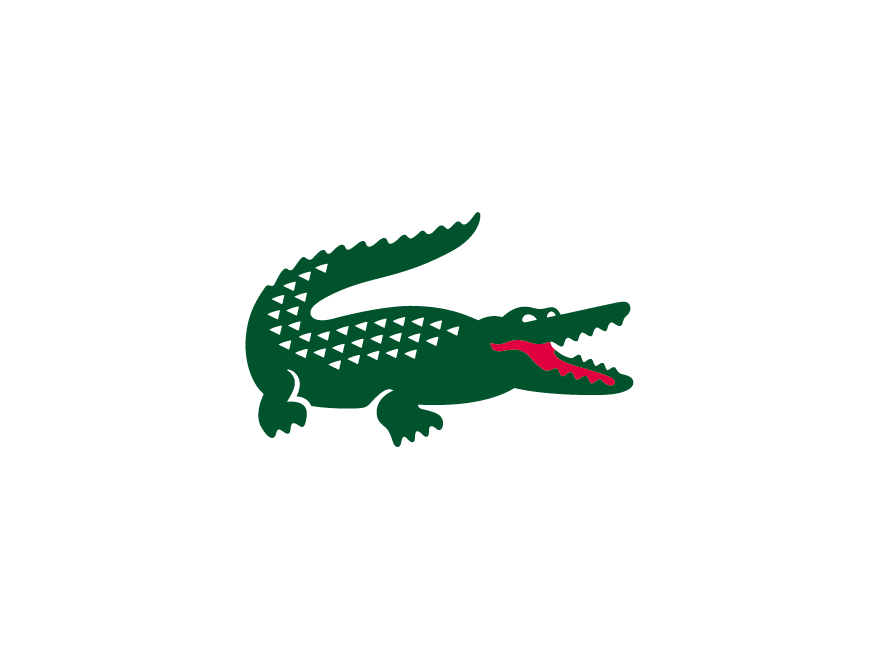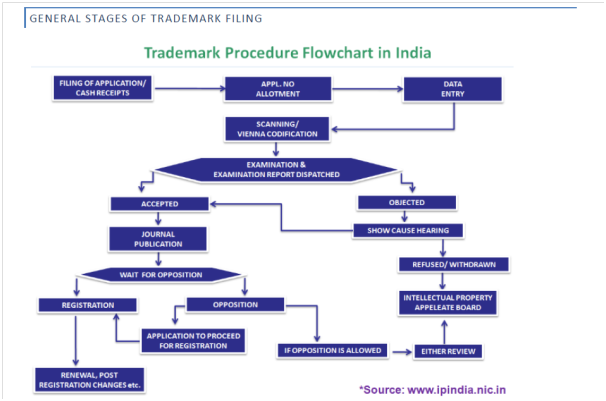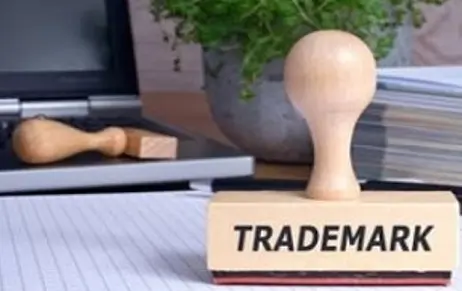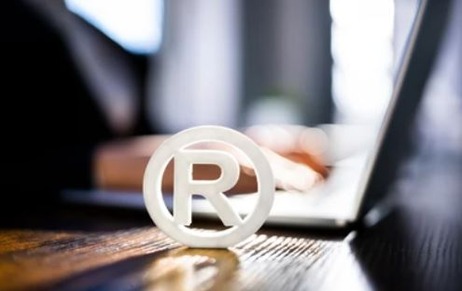TRADEMARK A trademark is something that we encounter on a regular basis. It is the…
Simplified account of Trademark Registration in India
We had written an article giving a simplified account of Patenting procedures in India to enable readers who are new to the Patents. A similar attempt is being made here to provide answers to the Trademark FAQs so as to enable readers who are new to the Trademark.
- What is a trademark? What is the mark? What are some examples?
Answer: Trademark can be defined as “trademark” means a mark capable of being represented graphically and which is capable of distinguishing the goods or services of one person from those of others and may include the shape of goods, their packaging, and combination of colors;..”.
“Mark” includes a device, brand, heading, label, ticket, name, signature, word, letter, numeral, shape of goods, packaging or combination of colors or any combination thereof.
Below are some examples of trademarks:
- Word: IBM, Google
- Fanciful designation: Kodak
- Names: Disney
- Slogan: Hum Hain Na! (ICICI bank limited)
- Device:
- Number: the 4711 cologne
7.Picture: 
Registering your trademark helps you secure exclusivity over your mark, helps you get geographical coverage throughout the country/region of registration, gives you a complete defense that you are not infringing the rights of other people, helps you create brand value.
- What does
and
signify, when can we use them?
Answer: is used to indicate that the trademark is unregistered but this mark is used to promote goods.
can be used even for trademarks for which registration is not applied to claim use over it.
is used to represent a registered trademark/ service mark that provides the applicant complete ownership and legal rights over the trademark/ service mark.
- Who can apply for a trademark? Where should the trademark application be filed?
Answer: An application can be made for registration of trademark actually used or proposed to be used by any person claiming to be the proprietor of the trademark. In India, for the facilitation of the registration of the trademarks, the Trademark registry operates from five locations i.e. Delhi, Mumbai, Ahmadabad, Kolkata, and Chennai. In the case of Indian applicants, jurisdiction is decided based on the principal place of business of the applicant and in the case of foreign applicants, jurisdiction is based on where the applicant’s agent or attorney is situated.
More info about jurisdiction and locations of the Trademark registry can be obtained by visiting http://www.ipindia.nic.in/locations-and-jurisdiction.htm
For e-filing, the manual available at https://ipindiaonline.gov.in/trademarkefiling/UsefullDownloads/User_Manual_etrademarkfiling.pdf may be referred.
- What are the general stages of trademark registration?
- An optional initial trademark search (identical search or similarity search) may be conducted on the government
- Once there is a go-ahead for trademark filing, an application for Trademark will be made through relevant forms provided by the trademark office/ Registrar of
- In the next step, the trademark office will issue an examination report and formality check report to communicate objections or to request clarifications with the There is no need to file a request for examination i.e. examination of a trademark is automatic. In this examination report, the mark is examined basically on three grounds i.e. distinctiveness, descriptiveness, and similarity to the prior marks. To qualify for registration, the mark should be distinctive, non-descriptive, and there should not be any similar prior marks.
- A reply has to be made to the trademark office in lieu of the reports that may be accepted or may be followed by a The applicant or agent if appointed is required to respond to the examiner’s objection(s) within a period of one month from the date of receipt of Examination Report. Failure to respond to the examination report within this specified period can lead to the abandonment of the application.
- If the trademark office is satisfied that the trademark request complies with all the necessary provisions under the act, the mark is advertised before
- Once the mark is advertised in the trademark journal, it is open for a period of 4 months for third parties to
- If no opposition is received during the specified period, the Trademark is deemed to be
- Once registered, there is no post-grant opposition.
- Is the registration of trademark compulsory?
Answer: No. Registration of a trademark is not compulsory. However, the registration is the prima facie evidence of the proprietorship of the trademark under registration. However, it is to be noted that no suit can be instituted for infringement of unregistered trademarks. For unregistered marks, action can be brought against any person for passing off goods or services as the goods of another person or as services provided by another person. The latter is said to be a common-law right.
- Can a registered trademark be amended at later date?
Answer: Yes, the filed mark is allowed to be amended as per the provision of Section 22 of the Trademarks Act, which allows the amendment of the mark provided it does not amount to a substantial change in the character of the mark as such. It is the practice of the Registrar of Trade Marks that if the mark applied as a label mark, any superficial or insignificant character or feature of the said mark is allowed to be amended if a request filed in the prescribed format along with 16 copies of the amended label mark.
- What is a collective Trademark?
The collective mark is owned by an association of persons not being a partnership. It belongs to a group and its use, therefore, is reserved for members of the group. The primary function of a collective mark is to indicate a trade connection with the association or organization that is the proprietor of the mark. Section 63 of the Trademarks Act, 1999, and Rule 128 of the Trademarks Rules, 2002 deal with this.
- What is the Certification mark?
The purpose of a certification trademark is to show that the goods or services in respect of which the mark is used have been certified by some competent person in respect of certain characteristics such as Origin, mode of manufacture, quality, etc. Section 74 of the Trademarks Act, 1999, and Rule 135 of the Trademarks Rules, 2002 deal with this.
- What are the modes of filing a trademark internationally? Can a foreign applicant claim the priority based on an earlier application?
Answer: International registration of a trademark is facilitated through Madrid Protocol which allows trademark application in one country/region to take priority from a trademark application filed in other countries/regions. This priority has to be claimed within six months. India is a member of the Madrid Protocol with effect from July 08, 2013.
- Once registered for what period of time, a trademark is effective? Can a trademark registration be renewed?
Answer: The registration of a trademark is valid for a period of 10 years. It can be renewed every 10 years, perpetually. In India, a renewal request is to be filed in form TM-12 within six months before the expiry of the last registration of a trademark. If the renewal fee is not paid till the expiration of the last registration, the surcharge has to be paid along with prescribed fee accompanied to form TM-10. If the renewal fee along with surcharge is not paid till the expiry of six months after the expiration of the last registration, the trademark is liable to be removed. Once removed, restoration of a trademark can be requested in form TM-13 along with prescribed fees and applicable renewal fees. TM-13 can be filed from six months of the expiration of the last registration till the expiry of 1 year from the expiration of the last registration.
- Is the trademark liable for removal on the ground of non-use?
Answer: Yes, a registered trademark can be removed on the basis of non-use. Except as excused in clause 3 of section 47 of trademarks act, 1999, a trademark may be removed on the ground of non-use if:
- that the trademark was registered without any bona fide intention and was not used till date three months before the date of the application for removal; or
- the trademark was not used for a continuous period of five years from the date of registration of trademark and application was made after three months from the expiry of five years.
- Is the sound or smell registrable as a trademark? How are these marks specified?
Answer: Yes, sounds or smells are registrable as a mark. However, they should be capable of being reproduced graphically and should be distinctive. Sound can be represented as musical notations along with the sound recording Smell can be represented as chemical formula along with the sample.
- Is a three-dimensional mark registrable?
Answer: Yes, a three-dimensional mark is registrable.
- What is the classification of goods adopted in India?
Answer: International Classification of goods and services (Nice Classification) is adopted in India.
- What are the grounds for refusal of registration of a trademark?
Answer: Section 9 of the trademarks act, 1999 provides absolute grounds, and section 11 provides relative grounds for refusal of registration of India. Trademark laws mandate trademark to be distinctive and non-descriptive in order to get registered. The rationale behind this provision is that non-distinctive or descriptive marks can’t be granted monopoly being generic to the trade and are open for public use without any exclusive rights over the same. Some of the examples of non-distinctive or descriptive marks are given below:
- Dalal street for financial services
- Best restaurant for food services
- Strong furniture for furniture
- High tech for technology-related goods/services
- Can a registered user restrain the third party from using an identical or similar mark if the third party is continuous and prior use of the mark?
Answer: A registered user can’t restrain the third party from using an identical or similar mark if the third party has been continuously using the mark in relation to the same goods or services for which the mark of the registered user is registered provided the third party has been using the mark from a date prior to the date of use of registered mark or date of registration, whichever is earlier.
- Before applying for registration, where can a search be done to check if identical or similar marks already exist?
Answer: In case you wish to carry out your own search (identical as well as similarity), the following are the recommended steps for the same:
At the first step, you may check your mark’s availability on a free government portal using the following steps:
- Go to the government search portal: https://ipindiaonline.gov.in/tmrpublicsearch/frmmain.aspx
- Select the relevant class of search from a list of 45 different business classes listed here: http://ipindiaonline.gov.in/tmrpublicsearch/classfication_goods_service.htm
For Wordmark:
- Search using the “Contain” in the drop-down instead of “Start With” to have a broader
- Please note that Trademark Registry will also object if the name is similar Thus, for better results, search similar sounding words as well. Example: A keyword like Kryzal can have the following terms that are similar sounding: Crizal, Crizal, Creezal, Crisal, Crysal, Creesal, Krizal, Kreezal, Krisal, Kreesal, Krysal.
- Also note that the website often encounters downtime error, and sometimes shows “no record found” while that is And thus a minimum of 2-time confirmation is recommended if such a scenario occurs.
- Please note that the normal update in the portal is done on an average period of one Thus recent filings will not reflect in the search.
- If you find any result similar to your mark and the same/ similar class or same similar business description, the name is recommended to be changed to avoid any objection/opposition during the trademark registration
For Logo:
- For a logo, a Vienna code classification search is to be carried The relevant Vienna code class can be searched on this interface: http://www.wipo.int/classifications/nivilo/vienna/index.htm# by clicking on the search button (top left) and then enter the keyword (top right), followed by a browse through the category to identify relevant Vienna Classification.
- Once the relevant Vienna code is found out, please enter the same in the Search interface using the dropdown to select Search Type as “Vienna Code” instead of “Wordmark”
- Enter the Relevant Vienna Code in the following format: 1.1.1 will become 010101 while 1.2.12 will become 010212.
- Enter the relevant class and Relevancy criteria will be similar to the wordmark





